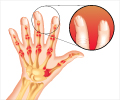Children with psoriasis are twice as likely to be obese or overweight as children who don't have the disease, states research.

In the US, children with psoriasis had four times the odds of being overweight or obese as healthy controls. Within this US population, Hispanics and African American children had significantly greater rates of being obese and overweight than whites and Asians. The odds ratio of being obese were particularly high for U.S. children with more severe psoriasis (7.6).
"There has been increasing attention to the association of psoriasis and metabolic risks in adults, but this study shows that the association of being overweight or obese and having psoriasis may be even higher in affected children than in adults," said Amy Paller, M.D., chair of dermatology at Northwestern University Feinberg School of Medicine and lead author of the study. She also is a pediatric dermatologist at the Ann and Robert H. Lurie Children's Hospital of Chicago.
The paper will be published Nov. 19 in Archives of Dermatology
"This is incredibly significant," Paller said. "It tells us these children are at increased risk of health complications (cardiac risk and insulin resistance) and need to be watched closely and treated."
The study included 614 children five to 17 years old from nine countries in the Americas, Europe and Asia.
Advertisement
In this study, about 30 percent of the affected children had an immediate family member with psoriasis, suggesting a strong genetic component. However, the reported family history of obesity was not higher in children with psoriasis than in control children.
Advertisement
"There is something in the genetic makeup of these kids that predisposes them to these metabolic issues and positions psoriasis as a metabolic disorder," noted Paller, also the Walter J. Hamlin Professor of Dermatology at the Feinberg School. "Psoriasis is driven by many of the same cytokines (proteins) that drive insulin resistance and being overweight."
Psoriasis is characterized by red, often itchy scaling lesions that can be localized (especially to the scalp, knees and elbows) or cover the entire body. The disease affects 2.5 to 3.5 percent of the global population with up to 33 percent of the cases starting in childhood, particularly during adolescence.
"It's a highly visible disease which can be devastating during the all-important years of psychosocial development of childhood and adolescence," Paller said. "It affects their social life and even their ability to participate in sports. Psoriasis has a profound effect on children's quality of life."
The study also looked beyond the commonly used Body Mass Index (BMI) to investigate psoriasis' link to central adiposity (fat around the waist) and the waist-to-height ratio, both of which are believed to have a higher correlation with metabolic risk. Internationally, the odds ratio of having a high waist-to-height ratio that imparted a high level of cardiac risk was 3.1 for all children with psoriasis and 4.1 for those with severe psoriasis.
"The bottom line is these kids need lifestyle intervention," Paller said. "You can't just treat psoriasis. You've got to work with these kids to increase exercise and decrease their caloric intake to reduce their risk for metabolic diseases. Perhaps losing weight could help their psoriasis as well." Previous studies in adults have suggested that weight loss can result in less severe symptoms.
A question not yet answered is which comes first, the psoriasis or the excess fat? Is a high BMI the precursor of psoriasis in children or does the disease lead to an increased BMI through chronic cytokine release from psoriatic tissues, compounded by a lifestyle that may contribute to excess fat? Paller is currently investigating that question.
Source-Eurekalert















